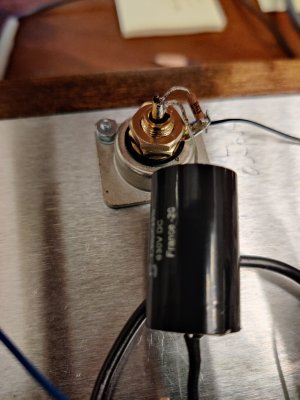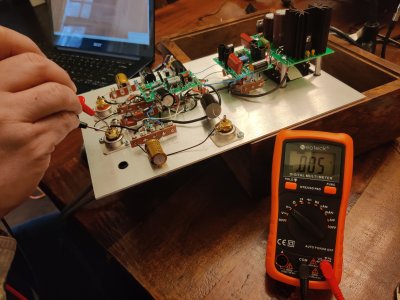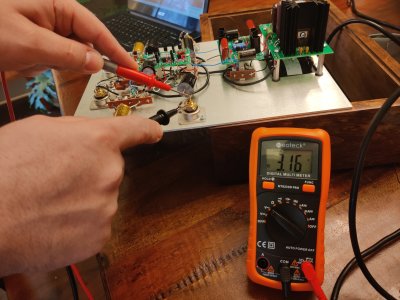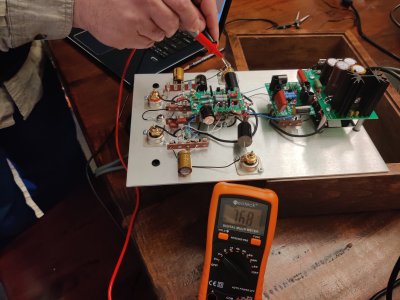You are using an out of date browser. It may not display this or other websites correctly.
You should upgrade or use an alternative browser.
You should upgrade or use an alternative browser.
Weak left Channel - What to check? [resolved]
- Thread starter jrhunter62
- Start date
jrhunter62
New member
I do not.
Gain at 1kHz of the Eros is about 50dB, and 5mV with 50dB of gain applied to it would give 1.5V of output.jrhunter62 said:I got the input signal as close to 5mV as I could. I'm not sure this meter does well at that low of a reading. With the unit on I got 3.46v on the left output and 6.96v on the right output.
It would help to know what you saw on your meter that was as close to 5mV as you could get so we can know whether the lower volume channel is the issue or whether the higher volume channel is the issue. So far it is looking more like the higher volume channel may actually be the issue, but it's not possible to say without concrete data.
jrhunter62
New member
I have attached pictures of the meter and what I am measuring. Previously I was concerned the meter might not have been up to it because the values were fluctuating, but I am able to get .005v consistently now.
Attachments
jrhunter62
New member
jrhunter62
New member
I took another picture of the right input measurement at .005v, but it isn't playing nice with the forum, you will have to take my word for it.
OK, taking 0.005V in and getting 3.16 out is 56dB. That's a little more than expected, but not impossible. If you are getting 7V out of the other channel under these conditions, I would be looking toward the EQ as the source of your issue. It could be something simple like the two little brown caps being swapped, or it's possible the 10.7K resistor got swapped for a different part by accident.
If a visual inspection doesn't turn up some swapped EQ components it might be helpful to measure at 100Hz, 1kHz and 10kHz again and note the voltage difference between channels at each of those frequencies. If the percentage of disparity is larger at one end of the spectrum than the other that might help to narrow down what components to check for a cold solder joint.
jrhunter62
New member
I can't find any components swapped or mis-wired
100Hz: R- 27.8, L- 18.63
1KHz: R- 7.68, L- 3.14
10KHz: R- .091, L- .026
100Hz: R- 27.8, L- 18.63
1KHz: R- 7.68, L- 3.14
10KHz: R- .091, L- .026
Can you double check that there's not an extra zero here?jrhunter62 said:10KHz: R- .091, L- .026
I would also be sure that your center C4S board is really well soldered. A loose 75K resistor on that board would do some strange things but the servo might be able to compensate on the DC side enough that it's only noticeable with AC.
Beyond that do you happen to have a spare 0.1uF/400V capacitor around? Or something similar? We can use that to check those levels on the plate of the EF86s, as many meters don't measure AC well in the presence of DC.
Paul Joppa
Moderator
Sure looks like it's the equalization. Because the 10kHz gain is most affected, my suspicion is that the 0.01uF and 0.03uF are swapped on the left channel.
In any case, the equalization is only four components - those two caps, and the 75K and 10.7K resistors.
In any case, the equalization is only four components - those two caps, and the 75K and 10.7K resistors.
jrhunter62
New member
Found it. I had the both 0.01uF on one side and both 0.03uF on the other. They are now in the correct places. I threw on a record and it sounds much better now. Thanks for sticking with me all week. Even with this hiccup it has been a blast putting this together and troubleshooting it. I have learned a lot and am excited to find my next build. Going to do a lot of listening this weekend and I will check back in and let you know how it goes. Thanks!
Paul Joppa
Moderator
Fabulous! Glad it's sorted now.
This thread reinforces the notion that sometimes it can be helpful to get a second set of eyes on the circuit. Even if those eyes are not experienced at building they may spot something that you have been looking at repeatedly and not seeing. Happens to all of us.
jrhunter62
New member
I agree completely. Where I work we call it 2nd party verification. Unfortunately my wife had little interest in checking my work. Most days I consider that a good thing!
Gerry E.
Member
I'm retired now but I worked in IT for 39 years. The classic IBM Mainframe trio of COBOL, CICS and DB2. There were definitely times when we needed another set of eyes to help debug our code. Fortunately, we had tools to allow us to single-step each line of code to see what was happening. Too bad there's nothing like that for kit building. OTOH, with the experience on this forum, problems can be narrowed down to the most likely culprits.
I mentioned this because while I don't really understand any of technical stuff, I find the debugging skills of PB, PJ and Doc fascinating. That's why I enjoy reading all of the threads.
Gerry
I mentioned this because while I don't really understand any of technical stuff, I find the debugging skills of PB, PJ and Doc fascinating. That's why I enjoy reading all of the threads.
Gerry
Paul Joppa
Moderator
Gerry - that "line by line" debugging is reflected in our increasing used of multiple pauses in the manuals to test the progress so far. (I didn't make the connection until I saw your post, but the principle is the same. Thanks!)
I honed my debugging using (mostly) FORTRAN from the same era ...
I honed my debugging using (mostly) FORTRAN from the same era ...
Similar threads
- Replies
- 26
- Views
- 12K






